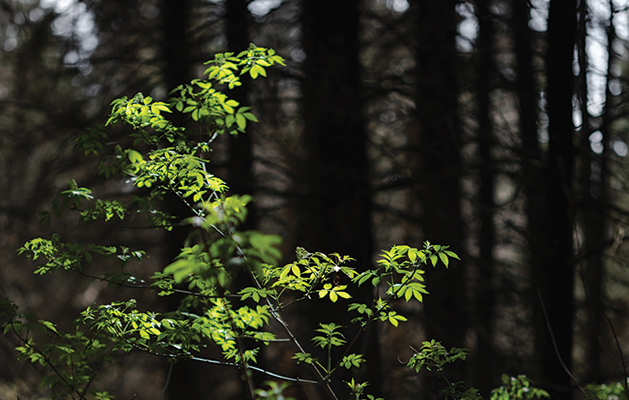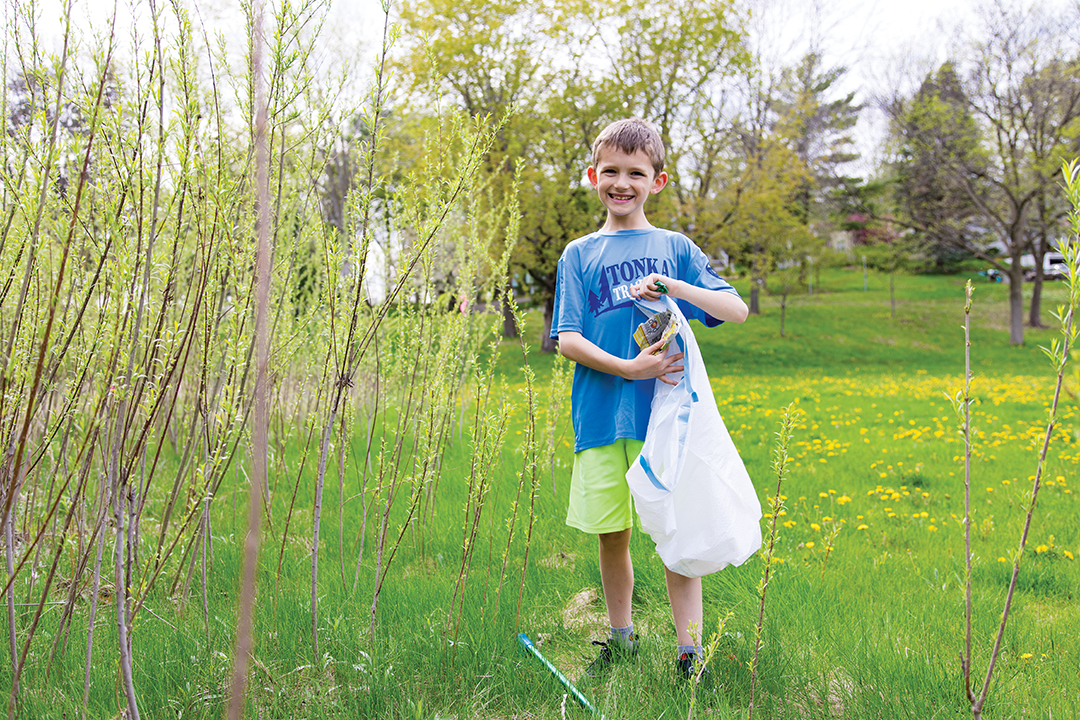
Photo: Sarah Dovolos
“Our affinity naturally leans toward green.”
No, you’re not submerged in water, and yes, you keep your clothes on. Forest bathing or shinrin-yoku via Japan is among the latest experiences that guide participants on an immersive, meditative and therapeutic forest walk, connecting their senses to the healing and stress-reducing beauty of a naturally-canopied vista.
Minnetonka Community Education (MCE) offers forest bathing programs, with two-hour sessions at Westwood Hills Nature Center in St. Louis Park.
“We first heard about [shinrin-yoku] on social media back in early 2019 and learned how popular it was in West Coast and other parts of the country,” says Jenny Bodurka, coordinator of Youth and Adult Programs. “… the community has responded well.”
MCE’s program is led by David Motzenbecker, certified through the Association of Nature and Forest Therapy Guides. “To be clear, I am not a therapist … The forest is the therapist. The guide just opens the door,” he says. (Through Motz Studios, he offers individual and group shinrin-yoku sessions.) Additionally, the award-wining landscape architect is certified as a forest bathing trail design consultant and created a trail at Silverwood Park (part of Three Rivers Park District) in St. Anthony that opened November 2020.
The walks include a series of guided invitations, which are centered on deepening sensory connections to the environment. “Much of our lives are lived on autopilot,” Motzenbecker says. “A forest bathing walk strives to rekindle our ability to pay attention to what our senses are telling us, leading us back to ourselves, allowing us to remember.”
How does this differ from a regular hike? “When most people go on a hike, the experience is informed by a goal— getting from point A to B …,” Motzenbecker says. “Forest bathing is the complete opposite. Wandering aimlessly is encouraged. Slowing down is something we also urge.” It’s not unusual to take two or three hours to walk a half mile.
“I give walks year-round,” Motzenbecker says. “Being able to immerse yourself in the beauty of each season is part of the enjoyment. Seeing a familiar park or forest change from winter to spring [or] summer to fall offers you a glimpse into deep time.” It doesn’t require a forest. “You can also forest bathe in prairies—any natural environment—even your backyard,” he says. “It just takes intention.”
Motzenbecker underscores the human-nature connection. “There is so much evidence … supporting the positive benefits … of a nature connection practice, such as shinrin-yoku,” he says. “… We evolved as a part of nature—not apart from nature—for hundreds of thousands of years. We have only truly been in modern cities for less than 300 [years]. The Industrial Revolution spawned a systematic and exponential disconnection from the woods, prairies and forests that formed us.”
Motzenbecker is passionate about widening the door to the outdoors. ”We have become digital zombies, numbingly thumbing our electronic pacifiers with glassy-eyed stares. Humanity can now claim the sad metric of having lower attention spans than a goldfish,” he says. “Seventy percent of humanity will be in cities by 2050, and we’ll spend 90 percent of our time indoors. When was the last time you experienced the sensations of the forest without being tethered to the global flow of bits and bytes via that slim piece of metal and glass in your pocket? We did not evolve in glass and steel and concrete ecosystems. Our affinity naturally leans toward green.”
The benefits of regaining connection with the natural world are bountiful, Motzenbecker notes, pointing to reducing stress; increasing focus, senses of calm and altruistic behavior; improving moods; and enhancing creativity. “Another benefit, reinforced by continued research, is the boosting of our immune systems, especially NK cells,” he says. “[They] respond quickly to a variety of invaders, such as viruses and early signs of cancer. Who wouldn’t want to boost their immunity given the current pandemic?”
The Association of Nature and Forest Therapy weighs in, too. “Forest bathing seems to significantly mitigate the root cause of a multitude of ailments: stress. Excess stress can play a role in headaches, high blood pressure, heart problems, diabetes, skin conditions, asthma and arthritis, among many other ailments,” it notes.
“One thing the pandemic has taught us is that the natural world is one of the few places left to us to relax and be safe at the same time,” Motzenbecker says. “The record number of people using parks is shockingly high comparatively to pre-COVID … Taking a quiet, intentional and immersive walk in the woods can give you back a bit of sanity.”
Motzenbecker, who has led the walks for three years, derives joy from his role. “I very much enjoy seeing the clouds lift and small revelations break across people’s faces while we’re on a walk, sharing what we’ve noticed,” he says.
Upcoming sessions through MCE are set for March 13, April 18 and May 15. For additional information, visit minnetonkaschools.org.
Minnetonka Community Education
Facebook: @minnetonka_community_education
Motz Studios
612.987.5971
Instagram: @forestbathingmpls






















